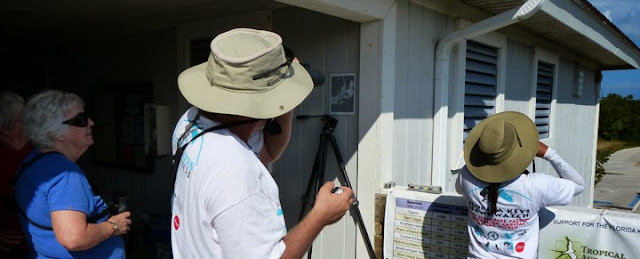 |
| Jo, left, stands in the shade while two of the bird counters track the flight of the Peregrine Falcon. |
We’re standing on the steps to the bathhouse at Curry Hammock State Park, just north of Marathon in the middle of The Keys. It’s a glorious day – sunny skies with bubbling cumulus clouds, azure blue water in the Atlantic to die for. All is right with the world.
We’re here because this very spot on the steps to the bathhouse is the Peregrine Falcon migration capital of the world. Thousands of birds of prey, or raptors, use the Florida Keys every fall as a migratory route to wintering grounds in the Caribbean and South America.
We’re visiting the official counters: dedicated people who drive from as far off as California (on their own migration, I would guess) to actually count each bird as it passes by their steps.
These folks – there were five of them when we stopped by – are VERY busy. They count thousands of hawks and other birds as they head down the Keys. They’re quite serious about keeping track of each and every species individually. They have clickers for the most popular species and the voices rise and fall as more and more birds fly into view.
We watched as hawks, falcons, eagles, ospreys, American kestrels, swallow-tailed kites, turkey vultures, black vultures, northern harriers deliberately flew by. Ripples of excitement followed each sighting by the counters as they clicked their counters and wrote the tally for each species.
The leader of the group told me one peregrine falcon was fitted with a GPS transmitter when it was released in New Jersey. In 24 hours it was tracked as it flew due south into the Atlantic until it came due east of Miami. It then took a hard right turn and came into the northern Keys where it turned left and headed southwest along the 100-mile chain of keys. This all occurred in the first 24 hours. Then it hopped across to South America and ended up on the southern coast of Chile.
How does it get the energy, I asked. “The falcon will catch birds like swallows on the wing,” the ornithologist told me. “He’ll tear it apart while flying and pack the bird into his craw.” With that, looking through his binoculars he said, “There’s one, right now, with a full craw.” The falcon swooped by at about 500 feet. He regurgitates the food in his craw when he needs the energy and swallows, never missing a beat. Extraordinary.
These migratory birds do this 24 hours a day. So the count by the team is quite conservative.
Here are the counts for some of the birds from 2012:
Osprey: 1,454
Bald Eagle: 22
Northern Harrier: 959
Sharp-shinned Hawk: 1,942
Cooper’s Hawk: 766
Red-shouldered Hawk: 23
Broad-winged Hawk: 7,236
American Kestrel: 3,242
Peregrine Falcon: 3,836
Mississippi Kite: 99
Swallow-tailed Kite: 40
What a wonderful experience to watch these birds slogging southward hour after hour.
We headed farther south ourselves with our friends Mike and Lucy who share campground duties with us. We passed through Marathon where Jo and I have spent many weeks at anchor, awaiting our own weather windows to be able to sail across the Gulf Stream to the Bahamas or back up to civilization in Miami and points north.
We eventually came to Bahia Honda State Park (there are 10 state parks in the Florida Keys) where we showed our passes and were honored guests. After 500 volunteer hours of work in the parks, we qualify for this pass which allows free entry to any of the hundreds of state parks.
We’re come to Bahia Honda to snorkel in the gin-clear water. Mmmmm. Delicious. Now this is what retirement is all about!
No comments:
Post a Comment